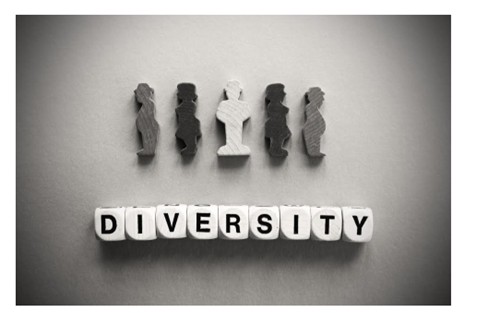
What is diversity in the workplace and why is it important?
25 Jun 2019Creating a diverse workplace starts by hiring people with different characteristics. However, there are huge benefits for businesses that look at it beyond recruitment. Leaders should see diversity as a powerful tool for creativity and innovation.
What is workplace diversity?
A diverse workforce describes a team made up of people with varying characteristics. Members may have different:
-
-
- Ethnicities.
- Ages.
- Religions.
- Cultural backgrounds.
- Sexual orientation.
-
It may also mean that people employed by the company:
-
-
- Have different levels of education.
- Speak a variety of languages.
- Provide a mixture of skill sets.
-
 Workplace diversity is about bringing together employees with different backgrounds and perspectives.
Workplace diversity is about bringing together employees with different backgrounds and perspectives.Why is diversity at work a priority?
Every organisation has a moral and legal obligation to support equal opportunities for all. However, workplace diversity benefits both the business and its employees well beyond the hiring cycle.
Perspective and approach
People with different life or career experience naturally approach problems differently. Therefore, diverse teams benefit from a wider range of ideas and are more likely to find the solution they need. Diverse approaches challenge everyone’s way of thinking and encourages ‘blue sky’ or ‘out-of-the-box’ problem solving.
Creativity and innovation
With a myriad of thoughts and ideas coming to the fore, employees are more likely to think harder about the ideas or opinions they contribute. Rather than suggesting the same approach as usual, they may be inspired by the approach of others to come up with more innovative ideas.
Diverse approaches to problem solving challenge everyone’s way of thinking.
ROI and productivity
Companies in the top quartile for having a racially and ethnically diverse team are 35 per cent more likely to see their financial performance sit above the industry average, according to research by McKinsey. With so much creativity, innovation and blue-sky thinking, diverse companies can quickly become more productive. A product designed this way is much more likely to be what audiences want.
Positive brand image
Highly diverse work cultures are viewed positively by consumers, both for their approach to hiring and their innovative products. Meanwhile, customer service is often very good, because clients can talk to someone who understands their needs.
How can leaders encourage and develop diversity in the workplace?
1) Tackle unconscious bias
Much of our behaviour is based on unconscious beliefs and judgments based on our experiences to date. By its very nature, most people are unaware of their unconscious bias, making it difficult to correct. A great example I saw recently is the different treatment of men and women on a much more subtle level than is often discussed. Consider:
-
-
- When it comes to an office birthday, who organises a cake, card or present?
- Who is more likely to get fresh coffee, tea or water in a meeting of equals?
-
While there are exceptions, most people I’ve asked admit that it’s a female team member who does both of the above.
Of course, combating unconscious bias extends beyond gender stereotyping. It’s about raising awareness and asking people to question their assumptions. Managers should be looking at their teams and asking themselves if they have the right mix of people involved. Have they assumed that certain people have nothing to contribute?
 Leaders should look at their teams, and consider how diverse they really are.
Leaders should look at their teams, and consider how diverse they really are.2) Promote inclusion from the top down
The benefits of diversity are impossible without a focus on inclusion, concludes research by Deloitte. They say that creating a culture that respects other people’s ideas and values difference of opinion is key. Employees must feel safe and confident when speaking up, knowing that their contribution is always valuable. This approach must start with leaders.
Deloitte’s study found that the right leadership approach increases employee feelings of inclusion by 70 per cent. As a result, team performance goes up by 17 per cent, employees collaborate 29 per cent more and the quality of decisions improves by 20 per cent.
How do leaders begin?
-
-
- Be curious about the ideas and opinions of all team members.
- Actively seek and create collaboration.
- Commit to diversity and challenge those who do not.
- Steer away from non-inclusive activities or jokes that rely on an understanding of particular language or cultural norms.
-
Every organisation must welcome and encourage diversity on an operational level.
3) Create an accessible company
From the hiring process through to day-to-day operations, every organisation must welcome and encourage diversity on an operational level. With recruitment, I find it’s particularly important to ensure recruiters are aware of both negative and positive unconscious bias. For example, they may be more inclined to hire someone because there is something familiar in them. While this doesn’t make them best-suited for the job, the individual hiring may think they see qualities that aren’t really there, because they’re probably as capable as themselves. Through positive bias, recruiters unfairly disadvantage other applicants without actually thinking anything negative of them.
Beyond recruitment, company policy and environment must support a diverse range of employees properly. Such an organisation should:
-
-
- Ensure both men and women can tailor their working day around childcare arrangements.
- Allow for religious and cultural beliefs, such as by providing a prayer room or celebrating a variety of festivals together.
- Help employees break down language barriers.
- Educate employees about cultural differences in professional conduct, such as in starting or ending meetings.
-
At ICML, we truly believe in the value of diversity. If you’re interested in learning about how you can lead the change in your organisation, take a look at our courses, including our new offering on ‘Diversity in the Workplace’.





